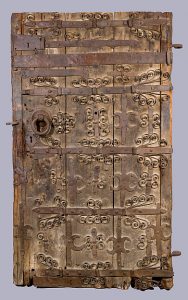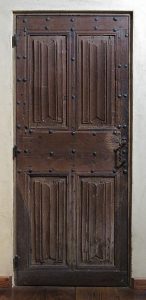 The Over-Under
The Over-Under
Mira sighed as she slathered on the last of the warding gel. The opening looked quite dusty, and the gel was certain to pick it up as she squeezed through. Getting her clothes clean afterward would prove a bother…
No lock or handle graces the iron door slightly too small for the frame. Light from beyond leaks through a space of almost an inch between jamb and door around the entire perimeter, interrupted in five spots on the right-hand side, where hinges or other hardware on the reverse block the light. The door sports three inset panels on its face. Lines of verse scratched into the surface of the middle panel read:
Over and under, or under and over:
It matters not, at break of day,
where timber burns to heat thy way.Be still the stone that bars the path,
lest hope be crushed in those that pass.Continue on then, as before
with care for winter’s steely hoar.Seven beats shall see thee safe,
‘fore breach doth pinch and start to chafe.Then risk ye must no bar to travel,
lest all your dreams and goals unravel.
Bars bisect each of the three inset panels on the reverse, preventing the door from opening. The top bar is fashioned from wood, the middle bar from stone, and the bottom bar from metal, discovered by closer scrutiny, or when the bars are removed and clatter to the ground with an appropriate sound. The wide gap in the frame facilitates this operation; a tool or slim blade fits into the gap, allowing the bars to be lifted out of the brackets on the far side.
If all three bars are removed, the entire door swings open, arming the crushing trap built into the threshold. Otherwise, as the top and bottom bars slip from their brackets, the corresponding inset panels crack open, permitting a Medium or smaller creature to squeeze through.
Safely navigating the narrow openings requires squeezing through alternating panels; it does not matter which panel is selected first. If a creature is stuck in one panel, the other may be used at the same time as long as the sequence is maintained (the stuck creature must clear itself before the pattern can continue). Failure to maintain the sequence, sets off both magical traps, as does spiking an open panel without first disarming them. Attempts to break the door or bars spring both panel traps; they deal damage for 7 rounds to any who interact with the door (randomize fire or cold damage).
The panels remain open for seven rounds before snapping shut, at which point, the only recourse is to remove the middle stone bar and risk the threshold trap. If a creature is stuck in a panel, it snaps shut as soon as the creature exits the breach.
 Pathfinder Statistics
Pathfinder Statistics
Perception: Discovering the material nature of each bar requires a DC 20 Perception check or a DC 14 Knowledge (engineering) check.
Magical Auras: faint transmutation (DC 17) from top and bottom inset panels.
Difficult Terrain: Squeezing through the narrow panel openings requires a full round and a DC 16 Escape artist check to navigate the top panel, DC 14 to navigate the bottom panel. Small creatures gain a +4 circumstance bonus to this check. Failure means the creature is stuck and must try again the following round.
Locking Panels: The panels lock shut 7 rounds after opening (DC 40 Disable Device, Hardness 10, hit points 60, Break DC 28) and deal residual heat or chill metal damage to any who interact with the door.
Arming Traps: The DC to discover the threshold trap is increased by 5 prior to the door being opened. A successful search after the door swings open (or an immediate check by a trap-spotter) spots the newly-armed trap.
HEAT METAL TOP PANEL TRAP CR 3
Type magical; Perception DC 27; Disable Device DC 27
EFFECTS
Trigger location; Reset none
Effect spell effect (heat metal), any creature passing through (or stuck in) the opening takes the damage indicted in the spell description based on how long the trap has been active. The damage emanates from the iron door itself, so the creature’s equipment has no bearing.
CHILL METAL BOTTOM PANEL TRAP CR 3
Type magical; Perception DC 27; Disable Device DC 27
EFFECTS
Trigger location; Reset none
Effect spell effect (chill metal), as above.
THRESHOLD CRUSH TRAP CR 3
Type mechanical; Perception DC 20; Disable Device DC 25
EFFECTS
Trigger location; Reset automatic
Effect +10 melee (4d6 bludgeoning damage)
5E Statistics
An Intelligence (investigation) check DC 15 reveals the materials from which each bar is fashioned; the door detects as magic. Wriggling through the top panel, which takes a full round, calls for a DC 15 Dexterity (acrobatics) check, the bottom panel is a DC 10 check; Small characters have advantage on the check. Each panel takes one round to heat or chill before dealing 2d8 fire or cold damage respectively for 6 more rounds. The re-setting Threshold trap is +7 to hit and deals dangerous damage. A DC 15 Perception check spots it (disadvantage if the door is closed), thieves’ tools and a DC 20 Dexterity check disable it. Heat metal and a DC 10 Intelligence (nature) check from the caster disables one of the panel traps; a DC 15 check disables both. Once activated, dispel magic counters only one ongoing effect. Forcing locked panels is a DC 25 Strength (athletics) check, lack of a proper tool like a crowbar or sledge grants disadvantage.
13th Age Statistics
Identifying the makeup of the bars is a Normal task. Squeezing through is a Hard Task to pass through the top panel, Normal to pass through the bottom and takes a full round. Small characters gain a +2 bonus on the roll. The panel traps take one round to heat or chill before dealing single-target Normal damage of the appropriate type each round for 6 rounds. Spotting the threshold trap is a Normal task when the door is open, Hard when closed, and disarming it is a Hard task. The crushing blow of the threshold trap attacks with a Normal attack roll and deals Hard single-target damage, resetting after each strike. Breaking through locked panels is Ridiculously Hard, proper tools grant a +2 bonus to the effort.
S&W Statistics
A dwarf automatically recognizes the materials making up each bar, otherwise a 3d6 intelligence check or a delicate tasks check yields the information. The panel traps deal damage as per heat metal (the chilling trap being a variant spell). A druid can cast heat metal to disarm the traps prior to setting them off: a successful 4d6 Wisdom check disables both, otherwise only one spell is countered. Dispel magic (vs a 9th-level caster) ends the ongoing effects of both traps. A 3d6 Dexterity check squeezes through the top panel, a 2d6+2 check through the bottom: small characters make the check twice and take the better result. The Threshold trap, automatically spotted by a dwarf, triggers on a 2 in 6, attacks with a +7 attack roll and deals 4d6 damage and then resets. It can be disabled normally when the door is open. Forcing locked panels requires an Open-Door check with a -1 penalty (a 1 on the die always succeeds).

Comments are closed.